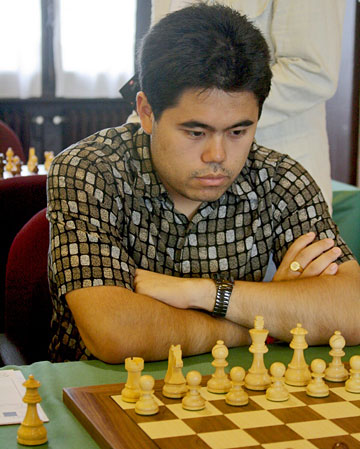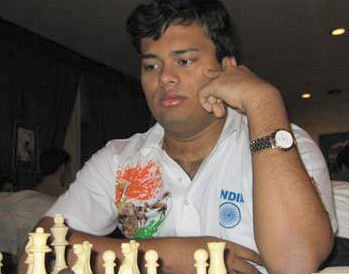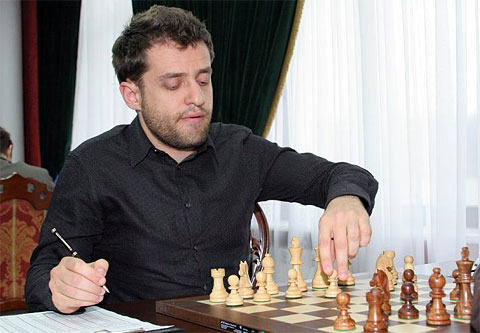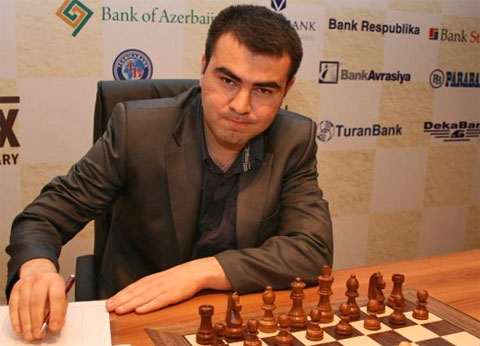| Latest | Greatest | Lobby | Journals | Search | Options | Help | Login |
|
|
|
This topic is archived. |
| Home » Discuss » Topic Forums » Sports |
|
| Jack Rabbit
|
Sun Jan-17-10 03:07 PM Original message |
| The JR Chess Report: Wijk aan Zee is Underway |
|
They're Underway in Wijk aan Zee
 The 72nd Corus Chess Tournament, divided into three groups, began yesterday in the Dutch resort town of Wijk aan Zee. Each group is a single round robin competition among 14 players. Group A, a category 19 grandmaster contest, this years features the world's top ranked play, 19-year-old Magnus Carlsen of Norway, reigning world champion Vishy Anand of India, former world champion Vladimir Kramnik and the reigning American champion, Hikaru Nakamura. After the second round played earlier today, Spanish grandmaster by way of Latvia Alexei Shirov is the only player to have won both his games. Carlsen and Nakamura, who both won today, are tied for second with a point and a half each. In Group B, German GM Arkadij Naiditsch, another Latvian expatriate, is the rating favorite. However, in the early going the group is led by 15-year-old reigning Dutch champion Anish Giri, whose mother is Russian and father is Nepalese. Naiditsch and Ni Hua of China are tied for second with a point and a half each. Group C is called the "Kindergarten" by the other players, since most of the players are under 21. The top seed player is Chinese grandmaster Li Chao, 20, followed by former world junior champion Abhijeet Gupta of India, also 20, and newly-invested grandmester Ray Robson of the United States, 15. After two rounds in Group C, young Robson leads the pack with a perfect score, followed by a four-way tie for second that inclues Li, Italian GM Daniele Vocaturo, 20, Dutch federation master Stefan Kuipers, 19, and 12-time Dutch women's champion Peng Zhaoqin, who immigrated to Holland from China before Ray Robson was born. In a game today between the school master and the governess of the Kindergarten, Mw. Peng defeated Norwegian GM Kjetil Lie, who is 29. Both of the Muzychuk sisters are playing in Wijk aan Zee this year. Anna, 19, who plays for Slovenia, is in Group B and currently has 1 point as a result of two draws, while 17-year-old Mariya, who plays for their native Ukraine, has a half point in Group C. The tournament runs through January 31 with rest days on January 20, 25 and 28. The entire tournament is covered at the official website. Games begin at 1:30 pm Dutch time (4:30 am PST). Gheam Maghami Leads Parsvnath Open in New Delhi  Iranian grandmaster Ehsan Ghaem Maghami has a perfect score after six rounds to stand alone in first place in the eighth annual Parsvnath International Open in the Indian capital of New Delhi. Gheam Maghami defeated Indian IM Oliver Dimakiling today in 49 moves. Tomorrow, Ghaem Magahmi will face Russian grandmaster Maxim Turov, who is in a three-way tie for second with 5½ points. Also in second place with 5½ points are Indian IMs Richad Bitoon and M. R. Lalith Babu. IM Tania Sachdev of India is the leading woman player with 5 points. There are over 370 players participating in the Parsvnath Open. The 11-round tournament concludes Friday. The tournament is being covered by the website of the Delhi Chess Association. Live coverage begins at 2:30 pm local time (1 am PST). Russia Takes the Gold as World Team Championship Concludes  Russia defeated Israel in the final round of the World Team Championship in Bursa, Turkey, Wednesday to take home the gold medal by two match points over the United States and India. Russia won their match with Israel by a score of 3-1 behind victories by reigning European champion Evgeny Tomashevsky and Nikita Vitiugov. The United States, which entered the round as the only team with a chance at catching Russia, played to a 2-2 tie against the reigning European team champions from Azerbaijan. India scored a victory over Brazil, 3½-½, to tie the US in match points. The US takes home the silver medal by virtue of 21½ individual points as opposed to the bronze medalists from India with 21. Hikaru Nakamura, the reigning US champion, won a gold medal for best score on the top board after scoring 6 points in the eight games he played. The gold medal for best overall score by any player went to Russia's Nikita Vitiugov, who scored 5½ out of six to edge out Shakhriyar Mamedyarov of Azerbaijan, who scored 8 out of nine. Calendar Corus Chess Tournament, Wijk aan Zee 15-31 January 2010. Group A: Anand, Carlsen, Caruana, Dominguez, Ivanchuk, Karjakin, Kramnik, Leko, Nakamura, Shirov, Short, Smmets, Tiviakov and van Wely. Group B: Akobian, Giri, Howell, L'Ami, A. Muzychuk, Naiditsch, Negi, Ni Hua, Nisipeanu, Nyback, Pentala, Reinderman, So and Sutovsky. Group C: Bok, Grandelius, Gupta, Kuipers, Li Chao, K. Lie, M. Muzychuk, Peng, Plukkel, Robson, Soumya, Swinkels, van Kempen and Vocaturo. Gibraltar Chess Festival 26 January-4 February. Moscow Open 29 January-8 February. Bundesliga 0910, Rounds 7-9, Munich, Mülheim, Berlin, Ramagen. 5-7 February. Aeroflot Open, Moscow 9-17 February. 27th Ciudad de Linares 12-25 February. Aronian, Gashimov, Gelfand, Grischuk, Topalov and Vallejo. Reykjavik Open 24 February-3 March. Bundesliga 0910, Rounds 10-11, Mülheim, Heidelburg, Solingen, Trier. 27-28 February. European Individual Championships, Rijeka (Croatia) 5-19 March. Melody Amber Rapid/Blindfold Tournament, Nice. 12-25 March. Aronian, Carlsen, Domínguez, Gelfand, Gashimov, Ivanchuk, Karjakin, Kramnik, Morozevich, Ponomariov, Smeets and Svidler. Philadelphia Open 31 March-4 April. This replaces the Foxwoods Open after the Foxwoods Resort announced expected room rate hikes. Russian Team Championships, Dagomys 1-12 April. Women's Grand Prix, Nalchik 23 April-6 May. Anand-Topalov Match for the World Title, Sofia 23 April-10 May. Grand Prix, Astrakhan (Russia) 9-25 May. US Championship, St. Louis 13-25 May. Chicago Open 27-31 May. Women's Grand Prix, Jermuk 23 June-6 July. World Open, Valley Forge, Pennsylvania 29 June-5 July. Women's Grand Prix, Ulan Bator (Mongolia) 29 July-12 August. World Junior Championships, Chotowa Czarna (Poland) 2-17 August. Chess Olympiad, Khanty Mansiysk 19 September-4 October. European Club Cup, Plovdiv 16-24 October. Women's Grand Prix, Vina del Mar (Chile) 27 October-9 November. World Youth Championships, Halidiki (Greece) 19-31 October. FIDE Women's Knock Out (Women's World Championship), Turkey 2-25 December. Games will be posted later today. |
| Printer Friendly | Permalink | | Top |
| Jack Rabbit
|
Sun Jan-17-10 05:08 PM Response to Original message |
| 1. This week's games |
|
Your humble hare acknowledges the assistance of Fritz 6.0 on analysis. Diagrams on the Jack Rabbit Chess Report are made with Chess Mérida, a true type font that can be downloaded free here. !""""""""# $tMvWlVmT% $OoOoOoOo% $ + + + +% $+ + + + % $ + + + +% $+ + + + % $pPpPpPpP% $RnBqKbNr% /(((((((() WHITE White to move (This position is a theoretical draw) I would like to thank my impressive and loyal staff: Buccaneer, Spitfire, Swashbuckler, Pancho and Robin Hood. |
| Printer Friendly | Permalink | | Top |
| Jack Rabbit
|
Sun Jan-17-10 05:09 PM Response to Reply #1 |
| 2. World Team Championship, Bursa |
| Printer Friendly | Permalink | | Top |
| Jack Rabbit
|
Sun Jan-17-10 05:10 PM Response to Reply #2 |
| 3. Sarwat - Vitigugov, Round 8 |
 Nakita Vitiugov Walaa Sarwat (Egypt) - Nikita Vitiugov (Russia) World Team Championship, Round 8/Board 4 Bursa, 12 January 2010 English Game: Reverse Benoni Opening 1.Nf3 d5 2.c4 d4 3.e3 Nc6 4.exd4 Nxd4 5.Nxd4 Qxd4 6.Nc3 c6
7.d3 Nh6
8.Be3 Qd8 9.d4!?
9...Nf5
10.Be2 g6
11.Qd2
11...Bg7 12.0-0-0
12...Qa5 13.Kb1 0-0 14.g4 Nxe3 15.fxe3
15...Rd8 16.Qc2
16...c5 17.dxc5
17...Bd7 18.Rd3!?
18...Bc6 19.Nd5 Qxc5 20.Rhd1
20...e6!
21.Nc3
21...Rxd3 22.Rxd3?
22...Rc8
23.Qd2
!""""""""# $ +t+ +l+% $Oo+ +oVo% $ +v+o+o+% $+ W + + % $ +p+ +p+% $+ NrP + % $pP Qb+ P% $+k+ + + % /(((((((() WHITE: Walaa Sarwat Position after 23.Qc2d3 23...Bf6!
24.Qe1
24...b5 25.cxb5 Be4!
26.Kc1 Bxd3 27.Bxd3 Bxc3 28.bxc3 Qa3+ 29.Kb1 Rxc3 30.Bc2 Qb4+ 31.Ka1 Qc5 0-1 !""""""""# $ + + +l+% $O + +o+o% $ + +o+o+% $+pW + + % $ + + +p+% $+ T P + % $p+b+ + P% $K + Q + % /(((((((() WHITE: Walaa Sarwat Final Position after 31...Qb4c5
|
| Printer Friendly | Permalink | | Top |
| Jack Rabbit
|
Sun Jan-17-10 05:12 PM Response to Reply #2 |
| 4. Tomashevsky - Roiz, Round 9 |
|
Reigning European champion Evgeny Tomashevsky contributed to Russia's gold medal finish by winning in the final round over Israel's Michael Roiz.
 Evgeny Tomashevsky Evgeny Tomashevsky (Russia) - Michael Roiz (Israel) World Team Championship, Round 9/Board 2 Bursa, 13 January 2010 Slav Queen's Gambit: Tikhi Opening 1.c4 c6 2.Nf3 Nf6 3.d4 d5 4.e3 Bf5 5.Nc3 e6 6.Nh4 Bg6
7.Nxg6
7...hxg6 8.a3
8...Nbd7 9.g3 Be7 10.b3
10...e5
11.Bg2
11...dxc4
12.bxc4
12...Nb6 13.Qd3 0-0!?
14.0-0 exd4 15.exd4 c5?!
!""""""""# $r+ W Tl+% $Oo+ VoO % $ M + Mo+% $+ O + + % $ +pP + +% $P Nq+ P % $ + + PbP% $R B +rK % /(((((((() WHITE: Evgeny Tomashevsky Position after 15...c6c5 16.d5!
16...Ne8
17.Ne4 f5 18.Nd2 Nd6 19.h4!?
!""""""""# $t+ W Tl+% $Oo+ + O % $ M M Vo+% $+ Op+o+ % $ +p+ + P% $P +q+ P % $ + N Pb+% $R B +rK % /(((((((() WHITE: Evgeny Tomashevsky Position after 19.h2h4 19...Bf6!
20.Ra2
20...Re8
21.Rc2
21...Qd7?!
22.Nb3!
22...Na4 23.Bf4
23...Rac8!?
24.Nd2!
24...Nb6 25.h5!
25...gxh5 26.Bxd6 Qxd6 27.Qxf5 h4?
!""""""""# $ +t+t+l+% $oo+ + O % $ M W V +% $+ Op+q+ % $ +p+ + O% $P + + P % $ +rN Pb+% $+ + +rK % /(((((((() WHITE: Evgeny Tomashevsky Position after 27...h5h4 28.Ne4!
28...Qe5
29.Qg6!
29...Nd7
30.Re2 Be7 31.Rfe1 Nf8 32.Qg4 1-0
|
| Printer Friendly | Permalink | | Top |
| Jack Rabbit
|
Sun Jan-17-10 06:04 PM Response to Reply #2 |
| 6. Gelfand - Nakamura, Round 5 |
|
This is only January, but this will go down as one of the best games played this year.
 Hikaru Nakamura Boris Gelfand (Israel) - Hikaru Nakamura (United States) World Team Championship, Round 5/Board 1 Bursa, 9 January 2010 West India Game: King's Indian Defense (Main Line) 1.d4 Nf6 2.c4 g6 3.Nc3 Bg7 4.e4 d6 5.Nf3 0-0 6.Be2 e5 7.0-0 Nc6
8.d5 Ne7 9.Nd2
9...Ne8 10.b4 f5 11.c5 Nf6
12.f3 f4 13.Nc4 g5 14.a4
14...Ng6 15.Ba3
15...Rf7 16.b5 dxc5
17.Bxc5 h5 18.a5 g4 19.b6 g3 20.Kh1 Bf8
21.d6!?
21...axb6
22.Bg1!?
22...Nh4?!
23.Re1?
!""""""""# $t+vW Vl+% $+oO + + % $ O P + +% $P + O +o% $ +n+pO M% $+ N +pO % $ + +b+pP% $R +qR Bk% /(((((((() WHITE: Boris Gelfand Position after 23.Rf1e1 23...Nxg2!!
24.dxc7
24...Nxe1!
25.Qxe1 g2+
26.Kxg2 Rg7+ 27.Kh1 Bh3 28.Bf1
!""""""""# $t+ W Vl+% $+o+ + T % $ O + M +% $P + O +o% $ +n+pO +% $+ N +p+v% $ + + + P% $R + QbBk% /(((((((() WHITE: Boris Gelfand Position after 28.Be2f1 28...Qd3!!
29.Nxe5
29...Bxf1 30.Qxf1
30...Qxc3
31.Rc1 Qxe5 32.c8Q Rxc8 33.Rxc8 Qe6 0-1
|
| Printer Friendly | Permalink | | Top |
| Jack Rabbit
|
Sun Jan-17-10 08:44 PM Response to Reply #2 |
| 7. Milos - Ganguly, Round 9 |
|
India took the bronze medal by defeating Brazil in the last round.
 Surya Shekhar Ganguly Gilberto Milos (Brazil) - Surya Shekhar Ganguly (India) World Team Championship, Round 9/Board 3 Bursa, 13 January 2010 Spanish Grand Royal Game: Neo-Classical Defense 1.e4 e5 2.Nf3 Nc6 3.Bb5 a6 4.Ba4 Nf6 5.0-0 b5 6.Bb3 Bc5 7.a4 Rb8 8.c3 d6 9.d4 Bb6
10.a5
10...Ba7 11.Be3
11...Bg4 12.dxe5!?
12...Bxf3
13.gxf3!?
13...dxe5 14.Qe2
14...0-0
15.Nd2 Nh5
16.Kh1 Qh4 17.Rg1
17...Nf4 18.Bxf4 exf4
19.e5?
!""""""""# $ T + Tl+% $V O +oOo% $o+ + + +% $Po+ P + % $ + + O +% $+bP +p+ % $ P NqW P% $R + + Rk% /(((((((() WHITE: Gilberto Milos Position after 19...e4e5 19...Qxf2!
20.Qxf2 Bxf2 21.Rg2 Be3!
22.e6
22...fxe6 23.Bxe6+ Kh8
24.Ne4
24...Ne5 25.Rf1
25...Rbe8 26.Bg4 Nc4 27.Ng5
27...Ba7 28.Rb1
!""""""""# $ + +tT L% $V O + Oo% $o+ + + +% $Po+ + N % $ +m+ Ob+% $+ P +p+ % $ P + +rP% $+r+ + +k% /(((((((() WHITE: Gilberto Milos Position after 28.Rf1b1 28...Ne3!
29.Rgg1 h6 30.Ne4 Re5 31.Bh3
31...g5 32.Bg4 Rd8 33.Bh5 Rd3 34.Rbe1
!""""""""# $ + + + L% $V O + + % $o+ + + O% $Po+ T Ob% $ + +nO +% $+ PtMp+ % $ P + + P% $+ + R Rk% /(((((((() WHITE: Gilberto Milos Position after 34.Rb1e1 34...Nc4!
35.Rg2 Ne3
36.Rgg1
36...Nc2
37.Rd1
37...Red5 38.Rxd3 Rxd3 39.Rc1
39...Ne3 40.Bf7 g4 41.Nf2
41...Rd2 42.Nxg4 Nxg4 43.fxg4 Rxb2!
44.Bd5 Be3 45.Rd1 c5 46.h4
!""""""""# $ + + + L% $+ + + + % $o+ + + O% $PoOb+ + % $ + + OpP% $+ P V + % $ R + + +% $+ +r+ +k% /(((((((() WHITE: Gilberto Milos Position after 46.h2h4 46...c4!
47.g5 hxg5 48.hxg5 Bd2 49.Kg2 b4 0-1
|
| Printer Friendly | Permalink | | Top |
| Jack Rabbit
|
Sun Jan-17-10 08:45 PM Response to Reply #2 |
| 8. Aronian - Nakamura, Round 8 |
|
This is the game that knocked the US out of first place.
 Levon Aronian Levon Aronian (Armenia) - Hikaru Nakamura (United States) World Team Championship, Round 8/Board 1 Bursa, 12 January 2010 West India Game: King's Indian Defense (Catalan Opening) 1.d4 Nf6 2.Nf3 g6 3.c4 Bg7 4.Nc3 d6 5.e4 0-0 6.Be2 e5 7.0-0 Nc6 8.d5 Ne7 9.Ne1
9...Nd7 10.Nd3
10...f5 11.Bd2 Nf6 12.f3 f4 13.c5 g5 14.cxd6
14...cxd6 15.Nf2 Ng6
16.Qc2
16...Rf7 17.Rfc1 Ne8
18.a4 h5 19.Ncd1!?
19...Bf8
20.Ra3 a6 21.Qc3 Bd7!?
22.Qa5
22...b6!?
!""""""""# $t+ WmVl+% $+ +v+t+ % $oO O +m+% $Q +pO Oo% $p+ +pO +% $R + +p+ % $ P BbNpP% $+ Rn+ K % /(((((((() WHITE: Levon Aronian Position after 22...b7b6 23.Qb4!
23...Rg7 24.Rac3!?
24...Nh4
25.h3 Be7!?
26.Be1 Qb8 27.Kf1!?
27...Bd8!?
28.Rb3
!""""""""# $tW Vm+l+% $+ +v+ T % $oO O + +% $+ +pO Oo% $pQ +pO M% $+r+ +p+p% $ P +bNp+% $+ RnBk+ % /(((((((() WHITE: Levon Aronian Position after 28.Rc3b3 28...Bc7!
29.Qa3 Qd8 30.Rbc3 Bb8!?
31.b4 Ra7 32.Rc6
32...b5?!
33.axb5 axb5 34.Ra6 Rb7
!""""""""# $ V Wn+l+% $+t+v+ T % $r+ O + +% $+o+pO Oo% $ P +pO M% $Q + +p+p% $ + +bNp+% $+ RnBk+ % /(((((((() WHITE: Levon Aronian Position after 34...Ra7b7 35.Rcc6?!
35...Bxc6!
36.dxc6 Ra7?!
37.Nc3 d5 38.Nxd5!
38...Nf5 39.exf5
39...Qxd5 40.Ne4 Rgc7
41.Nxg5?!
41...Ng7?
!""""""""# $ V + +l+% $T T + M % $r+p+ + +% $+o+wOpNo% $ P + O +% $Q + +p+p% $ + +b+p+% $+ + Bk+ % /(((((((() WHITE: Levon Aronian Position after 41...Ne8g7 42.Rb6!!
42...Nxf5 43.Rxb8+ Kg7 44.Qb2
44...Ra2 45.Qb1 Rc2 46.Rxb5
46...Qd6 47.Rb7 Kh6 48.Kg1 Qxc6
49.Nf7+ Rxf7 50.Rxf7 Ne3 51.Ra7 Qd5
52.Qa1 Nxg2 53.Qa6+ 1-0
|
| Printer Friendly | Permalink | | Top |
| Jack Rabbit
|
Sun Jan-17-10 08:48 PM Response to Reply #2 |
| 9. Ezat - Mamedyarov, Round 5 |
|
Shakh Mamedyarov played in all nine rounds. He won 7 and drew 2.
 Shakhriyar Mamedyarov Mohamed Ezat (Egypt) - Shakhriyar Manedyarov (Azerbaijan) World Team Championship, Round 5/Board 3 Bursa, 9 January 2010 Slav Queen's Gambit: Marshall Opening 1.d4 d5 2.c4 e6 3.Nc3 c6 4.e4
4...Bb4
5.Bd2!?
5...dxc4 6.Bxc4 Qxd4 7.Qe2 e5!?
8.0-0-0
8...Qc5 9.Kb1 Nf6 10.a3 Bxc3 11.Bxc3 a5
12.Nf3 b5
13.Ba2 Bg4!?
14.Rc1?!
!""""""""# $tM +l+ T% $+ + +oOo% $ +o+ M +% $OoW O + % $ + +p+v+% $P B +n+ % $bP +qPpP% $+kR + +r% /(((((((() WHITE: Mohamed Ezat Position after 14.Rd1c1 14...Qe7!
15.Qe1
15...Nbd7!
16.Bxa5 c5 17.b4 c4!?
18.a4!
18...bxa4
19.Nd2!
19...Nc5
20.Nxc4 Nb3
21.Bxb3 axb3
22.Qc3 0-0 23.Qxe5!?
23...Qd7 24.Nb2?
!""""""""# $t+ + Tl+% $+ +w+oOo% $ + + M +% $B + Q + % $ P +p+v+% $+o+ + + % $ N + PpP% $+kR + +r% /(((((((() WHITE: Mohamed Ezat Position after 24.Nc4b2 24...Nxe4!!
25.f3
25...Rfe8!
26.Qc7
26...Qd4!
27.fxe4 Qxe4+ 28.Ka1 Qxb4 29.Rc5 Qa3+!
30.Kb1 Qa2+ 31.Kc1 Qa1+ 32.Kd2 Qxb2+ 0-1
|
| Printer Friendly | Permalink | | Top |
| Jack Rabbit
|
Sun Jan-17-10 05:16 PM Response to Reply #1 |
| 5. Bonus Game: Larsen - Petrosian, IT, Santa Monica, 1966 |
|
Danish grandmaster Bent Larsen was Bobby Fischer's strongest rival for the unofficial title of best chess player outside the Soviet Union from 1959 until 1971.
 Bent Larsen Bent Larsen - Tigran Petrosian Second Piagorsky Cup, Round 7 Santa Monica, July 1966 Open Sicilian Game: Accelerated Dragon Defense (Maroczy Opening) 1.e4 c5 2.Nf3 Nc6 3.d4 cxd4 4.Nxd4 g6 5.Be3
5...Bg7 6.c4
6...Nf6 7.Nc3 Ng4
8.Qxg4 Nxd4 9.Qd1 Ne6
10.Qd2 d6
11.Be2 Bd7 12.0-0
12...0-0 13.Rad1
13...Bc6 14.Nd5
14...Re8!?
15.f4
15...Nc7
16.f5 Na6 17.Bg4
17...Nc5 18.fxg6 hxg6!?
19.Qf2!
19...Rf8 20.e5!?
20...Bxe5!
21.Qh4
21...Bxd5 22.Rxd5 Ne6 23.Rf3 Bf6?
24.Qh6!
24...Bg7 25.Qxg6!
25...Nf4
!""""""""# $t+ W Tl+% $Oo+ OoV % $ + O +q+% $+ +r+ + % $ +p+ Mb+% $+ + Br+ % $pP + +pP% $+ + + K % /(((((((() WHITE: Bent Larsen Position after 25...Ne6f4 26.Rxf4!!
26...fxg6 27.Be6+ Rf7
28.Rxf7 Kh8 29.Rg5 b5 30.Rg3 1-0
|
| Printer Friendly | Permalink | | Top |
| Jack Rabbit
|
Tue Jan-19-10 02:43 PM Response to Original message |
| 10. Update (Tuesday): Shirov on Fire at 1st rest day in Wijk aan Zee |
|
Edited on Tue Jan-19-10 02:45 PM by Jack Rabbit
 Spanish grandmaster Alexei Shirov is red hot in Group A as the first of three scheduled rest days comes to the 73nd Corus Tournament in the North Sea resort of Wijk aan Zee, Holland.  Alexei Shirov Shirov has won all four of his games. In three of those, he has won a 500 prize for best game of the round. Shirov is not only winning, he is winning in style. World number one Magnus Carlsen, reigning US champion Hikaru Nakamura and Ukrainian GM Vassily Ivanchuk are tied for second with three points each. In Group B, 15 year-old Dutch national champion Anish Giri and Chinese GM Ni Hua are tied for first with three points each. Another 15-year-old grandmaster, Ray Robson of the United States, is tied for first place with Li Chao of China in Group C with 3½ point apiece. After tomorrow's rest day, play resumes Thursday. |
| Printer Friendly | Permalink | | Top |
| DU
AdBot (1000+ posts) |
Thu Apr 25th 2024, 05:00 PM Response to Original message |
| Advertisements [?] |
| Top |
| Home » Discuss » Topic Forums » Sports |
|
Powered by DCForum+ Version 1.1 Copyright 1997-2002 DCScripts.com
Software has been extensively modified by the DU administrators
Important Notices: By participating on this discussion board, visitors agree to abide by the rules outlined on our Rules page. Messages posted on the Democratic Underground Discussion Forums are the opinions of the individuals who post them, and do not necessarily represent the opinions of Democratic Underground, LLC.
Home | Discussion Forums | Journals | Store | Donate
About DU | Contact Us | Privacy Policy
Got a message for Democratic Underground? Click here to send us a message.
© 2001 - 2011 Democratic Underground, LLC